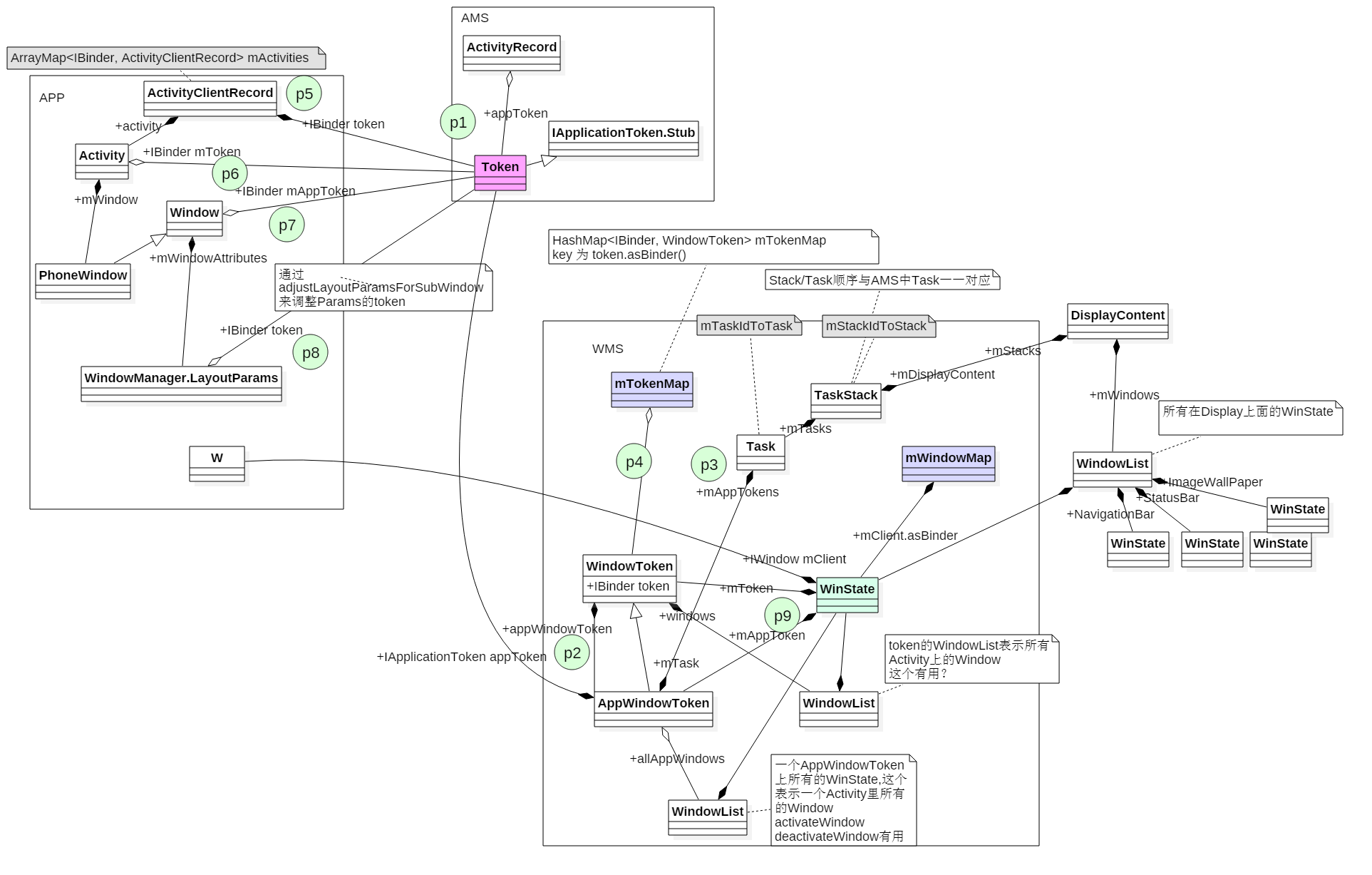https://upload-images.jianshu.io/upload_images/5688445-6cf0575bb52ccb45.png
1. ActivityRecord中的token
ActivityRecord在ActivityStackSupervisor的startActivityLocked初始化
final int startActivityLocked(IApplicationThread caller, Intent intent, String resolvedType, ActivityInfo aInfo, IVoiceInteractionSession voiceSession, IVoiceInteractor voiceInteractor, IBinder resultTo, String resultWho, int requestCode, int callingPid, int callingUid, String callingPackage, int realCallingPid, int realCallingUid, int startFlags, Bundle options, boolean componentSpecified, ActivityRecord[] outActivity, ActivityContainer container, TaskRecord inTask) { ActivityRecord r = new ActivityRecord(mService, callerApp, callingUid, callingPackage, intent, resolvedType, aInfo, mService.mConfiguration, resultRecord, resultWho, requestCode, componentSpecified, this, container, options); err = startActivityUncheckedLocked(r, sourceRecord, voiceSession, voiceInteractor, startFlags, true, options, inTask); }
ActivityRecord
ActivityRecord(ActivityManagerService _service, ProcessRecord _caller, int _launchedFromUid, String _launchedFromPackage, Intent _intent, String _resolvedType, ActivityInfo aInfo, Configuration _configuration, ActivityRecord _resultTo, String _resultWho, int _reqCode, boolean _componentSpecified, boolean _rootVoiceInteraction, ActivityStackSupervisor supervisor, ActivityContainer container, Bundle options) { service = _service; appToken = new Token(this, service); info = aInfo; launchedFromUid = _launchedFromUid; launchedFromPackage = _launchedFromPackage; userId = UserHandle.getUserId(aInfo.applicationInfo.uid); intent = _intent; shortComponentName = _intent.getComponent().flattenToShortString(); resolvedType = _resolvedType; componentSpecified = _componentSpecified; rootVoiceInteraction = _rootVoiceInteraction; configuration = _configuration; stackConfigOverride = (container != null) ? container.mStack.mOverrideConfig : Configuration.EMPTY; resultTo = _resultTo; resultWho = _resultWho; requestCode = _reqCode; state = ActivityState.INITIALIZING; //... }
Token是ActivityRecord内部类330行
http://androidxref.com/6.0.1_r10/xref/frameworks/base/services/core/java/com/android/server/am/ActivityRecord.java
static class Token extends IApplicationToken.Stub { private final WeakReference<ActivityRecord> weakActivity; private final ActivityManagerService mService; Token(ActivityRecord activity, ActivityManagerService service) { weakActivity = new WeakReference<>(activity); mService = service; } //... }
启动一个Activity的时候会为这个Activity生成一个ActivityRecord对象,该对象用于AMS管理跟踪,而 Token就在这里诞生了。
Token类实现了IApplicationToken.Stub,也就是作为Binder的服务端,那么它自然的接收客户端的请求,那它主要提供什么样的服务呢?
看下android/view/IApplicationToken.aidl
interface IApplicationToken { void windowsDrawn(); void windowsVisible(); void windowsGone(); boolean keyDispatchingTimedOut(String reason); long getKeyDispatchingTimeout(); }
可以看出,大部分是WindowManagerService用于通知ActivityManagerService的关于Window的消息,也有key的相关消息
2. WMS中的token
WMS专为Activity实现了一个WindowToken的子类:AppWindowToken
具体位置为ActivityStack.startActivityLocked(),也就是启动Activity的时候。相关代码如下:ActivityStack.startActivityLocked()
private final void startActivityLocked(......) { ...... mService.mWindowManager.addAppToken(addPos,r.appToken, r.task.taskId, r.info.screenOrientation, r.fullscreen); ...... }
startActivityLocked()向WMS声明r.appToken作为此Activity的Token,这个Token是在ActivityRecord的构造函数中创建的。
将ActivityRecord中的appToken加入到WMS中
public void addAppToken( ) { //生成ActivityRecord在WMS中对应的AppWindowToken,并引用到ActivityRecord中的Token,见p2 atoken = new AppWindowToken(this, token, voiceInteraction); //如果没有Task, 就创建一个task, 并加入到stack中, //这里的task/stack都是与AMS中task/stack就一一对应的。 见p3 Task task = mTaskIdToTask.get(taskId); if (task == null) { task = createTaskLocked(taskId, stackId, userId, atoken, taskBounds, config); } //将AppWindowToken加入到task中管理起来 task.addAppToken(addPos, atoken, taskResizeMode, homeTask); mTokenMap.put(token.asBinder(), atoken); //加入到mTokenMap中, 见p4 }
AppWindowToken(WindowManagerService _service, IApplicationToken _token, boolean _voiceInteraction) { //将token的binder对象给AppWindowToken的父类WindowToken引用 super(_service, _token.asBinder(), WindowManager.LayoutParams.TYPE_APPLICATION, true); appWindowToken = this; appToken = _token; //引用到ActivityRecord中的Token voiceInteraction = _voiceInteraction; mInputApplicationHandle = new InputApplicationHandle(this); mAppAnimator = new AppWindowAnimator(this); }
wtoken.appToken.windowsDrawn();
wtoken.appToken.windowsVisible();
appWindowToken.appToken.keyDispatchingTimedOut(reason);
作用
WindowManagerService中AppWindowToken保存着ActivityManagerService Binder对象,用来向AMS传递Window和按键的一些信息.
另外的一个用处是作为 mTokenMap的key
mTokenMap.put(token.asBinder(), atoken);
3. App中的token
attachApplicationLocked realStartActivityLocked app.thread.scheduleLaunchActivity(new Intent(r.intent), r.appToken, );
public final void scheduleLaunchActivity(Intent intent, IBinder token, ) { //生成App中的ActivityClientRecord ActivityClientRecord r = new ActivityClientRecord(); r.token = token; //将AMS中的token保存到 ActivityClientRecord中 见P5 }
将AMS中的token保存到 ActivityClientRecord中
http://androidxref.com/6.0.1_r10/xref/frameworks/base/core/java/android/app/ActivityThread.java
public final class ActivityThread { //... private ContextImpl mSystemContext; static IPackageManager sPackageManager; final ApplicationThread mAppThread = new ApplicationThread(); final Looper mLooper = Looper.myLooper(); final H mH = new H(); final ArrayMap<IBinder, ActivityClientRecord> mActivities = new ArrayMap<>(); // List of new activities (via ActivityRecord.nextIdle) that should // be reported when next we idle. ActivityClientRecord mNewActivities = null; // Number of activities that are currently visible on-screen. int mNumVisibleActivities = 0; WeakReference<AssistStructure> mLastAssistStructure; final ArrayMap<IBinder, Service> mServices = new ArrayMap<>(); //... }
AMS将ActivityRecord的appToken传递给App进程。
//ActivityThread
private void handleLaunchActivity(ActivityClientRecord r, Intent customIntent) { //... //获取WindowManagerService的Binder引用(proxy端)。 WindowManagerGlobal.initialize(); //会调用Activity的onCreate,onStart,onResotreInstanceState方法 Activity a = performLaunchActivity(r, customIntent); if (a != null) { //... //会调用Activity的onResume方法. handleResumeActivity(r.token, false, r.isForward, !r.activity.mFinished && !r.startsNotResumed, r.lastProcessedSeq, reason); //... } }
//ActivityThread private Activity performLaunchActivity(ActivityClientRecord r, Intent customIntent) { //通过类加载器创建Activity Activity activity = mInstrumentation.newActivity(cl, component.getClassName(), r.intent); //... //通过LoadedApk的makeApplication方法来创建Application对象 Application app = r.packageInfo.makeApplication(false, mInstrumentation); if (activity != null) { //... activity.attach(appContext, this, getInstrumentation(), r.token, r.ident, app, r.intent, r.activityInfo, title, r.parent, r.embeddedID, r.lastNonConfigurationInstances, config, r.referrer, r.voiceInteractor, window); //... //onCreate mInstrumentation.callActivityOnCreate(activity, r.state); //onStart activity.performStart(); } return activity; }
在Activity的attach()方法里,系统会创建Activity所属的Window对象并为其设置回调接口,由于Activity实现了Window的Callback接口,因此当Window接收到外界的状态改变时就会回调Activity的方法。Callback接口中的方法很多,下面举几个比较眼熟的方法。
public interface Callback { public boolean dispatchTouchEvent(MotionEvent event); public View onCreatePanelView(int featureId); public boolean onMenuItemSelected(int featureId, MenuItem item); public void onContentChanged(); public void onWindowFocusChanged(boolean hasFocus); public void onAttachedToWindow(); public void onDetachedFromWindow(); }
//Activity final void attach(...) { //绑定上下文 attachBaseContext(context); //创建Window,PhoneWindow是Window的唯一具体实现类 mWindow = new PhoneWindow(this, window);//此处的window==null,但不影响 mWindow.setWindowControllerCallback(this); mWindow.setCallback(this); //... //设置WindowManager mWindow.setWindowManager( (WindowManager)context.getSystemService(Context.WINDOW_SERVICE), mToken, mComponent.flattenToString(), (info.flags & ActivityInfo.FLAG_HARDWARE_ACCELERATED) != 0); if (mParent != null) { mWindow.setContainer(mParent.getWindow()); } //创建完后通过getWindowManager就可以得到WindowManager实例 mWindowManager = mWindow.getWindowManager();//其实它是WindowManagerImpl } @Override public Object getSystemService(@ServiceName @NonNull String name) { //... if (WINDOW_SERVICE.equals(name)) { return mWindowManager; } return super.getSystemService(name); }
等,等一下。看到这里是不是有点懵,Activity的getSystemService根本没有创建WindowManager,那么mWindow.setWindowManager()设置的岂不是空的WindowManager,那这样它的下一步mWindowManager = mWindow.getWindowManager()岂不是无线空循环?
因为PhoneWindow中并没有setWindowManager()方法,所以我们打开Window类看看。
//Window public void setWindowManager(WindowManager wm, IBinder appToken, String appName, boolean hardwareAccelerated) { mAppToken = appToken; mAppName = appName; mHardwareAccelerated = hardwareAccelerated || SystemProperties.getBoolean(PROPERTY_HARDWARE_UI, false); if (wm == null) { wm = (WindowManager)mContext.getSystemService(Context.WINDOW_SERVICE); } //在此处创建mWindowManager mWindowManager = ((WindowManagerImpl)wm).createLocalWindowManager(this); } //在WindowManagerImpl类中 public WindowManagerImpl createLocalWindowManager(Window parentWindow) { return new WindowManagerImpl(mContext, parentWindow); }
作用
Activity中的token涉及到多个地方,
-
ActivityClientRecord
这个类是Activity在ActivityThread中一一对应的,一个APP有多个Activity, 也就是说有多个ActivityClientRecord, 那么当AMS要启动一个Activity的时候,怎么样找到APP中正确的那个Activity呢?答案就是通过Token,
如:
public final ActivityClientRecord performResumeActivity(IBinder token, boolean clearHide, String reason) { ActivityClientRecord r = mActivities.get(token); r.activity.performResume(); }
先通过token找到ActivityClientRecord,然后再通过ActivityClientRecord中的activity就找到了正确的Activity了
- Activity
Activity中Token主要用于在请求AMS服务时用于定位到具体到AMS中正确的ActivityRecord
比如进入PIP模式,通过Token,AMS就可以知道具体是哪个Activity进入PIP,
public void enterPictureInPictureMode() { try { ActivityManagerNative.getDefault().enterPictureInPictureMode(mToken); } catch (RemoteException e) { } }
又比如 startActivityForResult,希望在finish时得到一些结果,那么AMS在finish那个Activity时,会把result传递给resultTo(mToken对应的那个Activity),
public void startActivityForResult(@RequiresPermission Intent intent, int requestCode, @Nullable Bundle options) { if (mParent == null) { Instrumentation.ActivityResult ar = mInstrumentation.execStartActivity( this, mMainThread.getApplicationThread(), mToken, this, intent, requestCode, options);
- Window
Window中的Token主要是传给LayoutParams, 见下面分析
4. WindowManager.LayoutParams里的token
WindowManager.LayoutParams是App中的,但是这里单独拿出来,是因为WMS会使用到它中的Token
ddView->setView public void addView(View view, ViewGroup.LayoutParams params, Display display, Window parentWindow) { if (parentWindow != null) {//这里parentWindow为PhoneWindow parentWindow.adjustLayoutParamsForSubWindow(wparams); } } void adjustLayoutParamsForSubWindow(WindowManager.LayoutParams wp) { ... } else { //这里为null, 且mContainer也为空,所以将mAppToken直接赋值给wp.token if (wp.token == null) { wp.token = mContainer == null ? mAppToken : mContainer.mAppToken; } } }
由上代码可知WindowManager.LayoutParams的token为Window中的mAppToken也就是AMS中ActivityRecord中的Token 见p8
作用
WindowManager.LayoutParams中的 token传递给WMS,
另外它的大部分作用是一致性判断
5. WindowState中的token
public int addWindow(WindowManager.LayoutParams attrs) { //attrs.token即是图中的p8, 这里拿到的token不为null, 具体参考 **WMS中的token** WindowToken token = mTokenMap.get(attrs.token); ... if (type >= FIRST_APPLICATION_WINDOW && type <= LAST_APPLICATION_WINDOW){ //这里atoken即是WindowToken的子类 AppWindowToken, 具体见p2 atoken = token.appWindowToken; } WindowState win = new WindowState(this, session, client, token, attachedWindow, appOp[0], seq, attrs, viewVisibility, displayContent); } WindowState(WindowManagerService service, Session s, IWindow c, WindowToken token, WindowState attachedWindow, int appOp, int seq, WindowManager.LayoutParams a) { mToken = token; //WindowState引用到WindowToken WindowState appWin = this; while (appWin.isChildWindow()) { //一个Activity上可能有多个窗口,这里找到父窗口 appWin = appWin.mAttachedWindow; } WindowToken appToken = appWin.mToken; // while (appToken.appWindowToken == null) { WindowToken parent = mService.mTokenMap.get(appToken.token); if (parent == null || appToken == parent) { break; } appToken = parent; } mRootToken = appToken; //这里mAppToken就是WindowToken的子类 AppWindowToken. 见P4 mAppToken = appToken.appWindowToken;
从上面代码看出WindowState也间接有ActivityRecord中的Token的引用。
作用
WMS中的token是通过WindowManager.LayoutParams传过来的,作用之一是作为
mTokensMap中的key值用来储存对应的WindowToken
作用之二是通知AMS一些消息,如
mActivityManager.notifyEnterAnimationComplete(atoken.token);
wtoken.appToken.windowsVisible();
